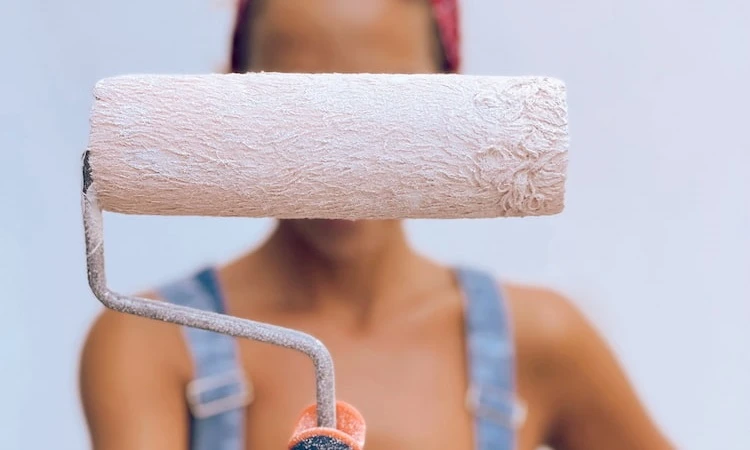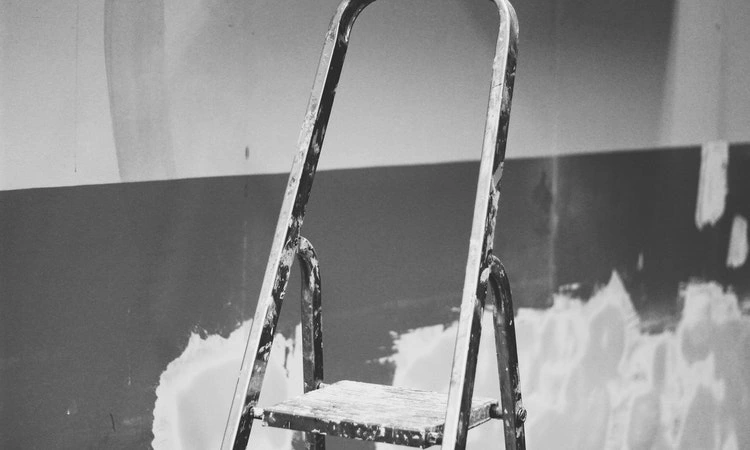Are you thinking about painting the foundation of your house? Maybe your foundation needs a new coat of paint?
Or maybe your HOA is forcing you to paint your foundation. Either way, you are here, and you want to know how and if you should paint your foundation.
There are a couple of reasons you should paint the foundation of your house. It increases curb appeal and protects from moisture and sunlight. The process of painting the foundation is relatively easy. However, it can be a little extensive.
You must prepare the brick or concrete foundation by cleaning it and completing repairs. After repairs are made, you can prime and paint your foundation.
Whether your foundation is brick or concrete will affect how you prep and paint the foundation.
You should continue reading to learn how specifically to prep and paint brick and concrete foundations.
I will provide full steps for both surfaces. I will also recommend some top paints for each type of foundation.
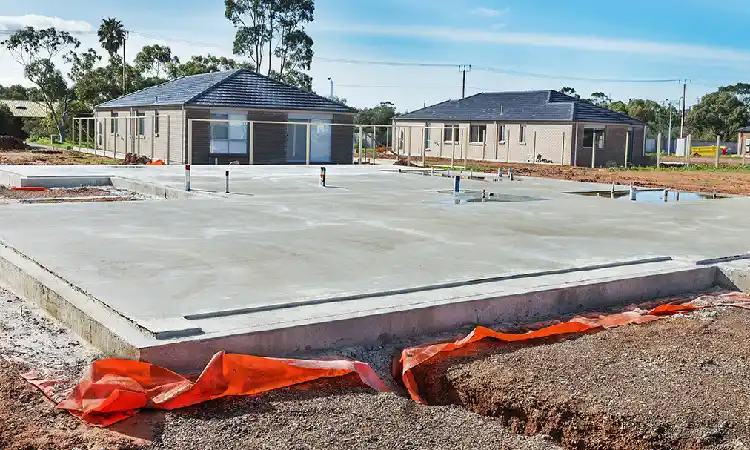
Can You Paint the Foundation of Your House?
Of course, you can paint the foundation of your house. It is considered an optional and nonessential task, but it does have a couple of benefits.
Before you take on painting your foundation, you will need to determine what material your foundation is made of.
Most foundations are made of concrete. Some of you may think your foundation is brick, but generally, the brick is covering up the concrete.
This is done on some houses because brick is more aesthetically pleasing with some architectural styles.
You will also need to determine if your foundation is covered in tar. Tar is often used as a waterproof and weatherproof barrier on foundations.
Unfortunately, you will not be able to paint over the tar. You must remove the tar using a pressure washer and a putty knife.
Why Should You Paint Your Foundation?
There are several reasons you should or may have to paint your foundation.
Below, I will describe 3 different reasons you should consider when deciding to paint your house’s foundation.
Curb Appeal
A painted foundation can increase the curb appeal of your house. It can take your drab and outdated foundation and turn it into the talk of the town.
It is recommended to repaint your foundation every 5-10 years.
This is easy to accomplish if you keep up with repainting the rest of your house.
Repainting your foundation and house simultaneously will drastically improve your house’s curb appeal, which is amazing and beneficial whether you are trying to sell your house or not.
Some homeowner’s associations (HOAs) will even require homeowners to paint their foundations.
They do this to keep the houses in the neighborhood looking nice and uniform. Keep in mind that some HOAs will dictate the color of paint you can use.
Moisture Protection
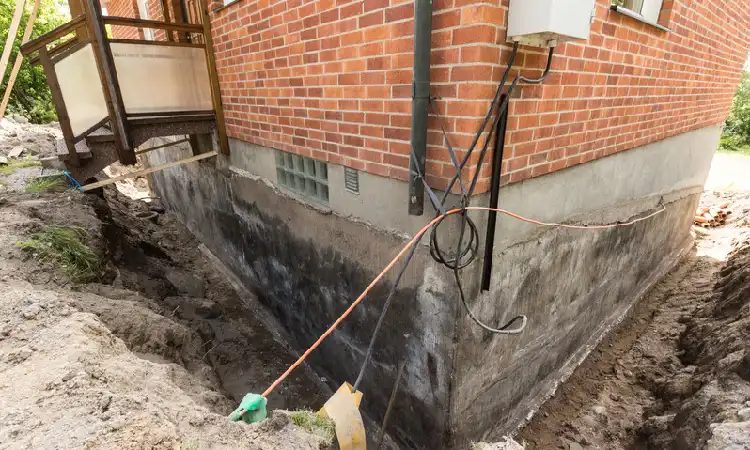
A painted foundation can add a layer of moisture protection to any house. Moisture can seep into the concrete and underlying wood structures. Over time, moisture can also cause the concrete to develop cracks.
Water that is caught in the foundation can expand when frozen. The expansion of the water can lead to cracks developing throughout the foundation.
Ultimately, this is not only an eyesore, but it can also affect the structural integrity of your home.
So how does paint protect the foundation from moisture damage? The paint seals off the pores of the underlying surfaces. This will prevent water from being able to seep into the underlying foundation.
Sunlight Protection
Concrete and bricks are durable, but they are still susceptible to sunlight damage. Over time sunlight can cause the walls of the foundation to deteriorate.
Sunlight can even cause mortar to crumble and cause small cracks or holes in the foundation.
How Do You Prepare the Foundation for Painting?
Preparing the foundation for painting differs slightly between concrete and brick foundations. The first step is to remove any debris around the foundation.
For example, piles of leaves that may have piled up should be removed before you paint the foundation.
This will create a clean working area for you. The next several steps will differ depending on your house’s type of foundation.
Below I will describe the different steps for preparing concrete and brick foundations before you can paint them.
Preparing Concrete Foundation For Painting
You should begin by cleaning the concrete foundation. A dirty foundation prevents the paint from properly adhering.
This means the paint can potentially crack and peel. You can use a pressure washer or a garden hose to clean the surface.
It is recommended to use a low setting on the pressure washer. The high setting may cause damage to the foundation.
Then you can use a wire brush to scrub off the remaining dirt and plant debris.
When the surface is clean, you can look for cracks and dents. A flexible sealant can be used to repair any cracks or chips you notice during your inspection.
Once you have completed any necessary repairs, the foundation will need to dry before you can begin to paint it fully.
Preparing Brick Foundation For Painting
Brick foundations can also be cleaned using a garden hose or a low setting on your pressure washer.
You may need to use trisodium phosphate (TSP) to clean difficult stains or remove old paint. You can mix ½ cup of TSP per gallon of water.
A bristle brush can then be used to remove the stuck-on debris. If there is mildew present, you will need to use a bleach solution to remove it.
Mix one part of bleach with three parts of water. The solution will have to soak for 30 minutes before using a bristle brush to scrub the mildew.
You should not use acid-cleaning products on bricks. They can negatively affect your paint project as they will prevent the paint from adhering to the surface of the brick.
Do you know if your brick was installed less than one year ago?
If it was, then you need to wait before painting the brick. This gives the mortar time to dry and cure. If it has been installed for years, you will need to check for any mortar damage.
The damage can be repaired using an acrylic caulk.
You will have to wait until the brick is completely dry before you begin painting it. Many professionals will recommend waiting a full 24 hours before you paint.
This is especially important if you have to repair any cracks in the brick.
What Kind of Paint Do You Use on Foundation?
There are a couple of different kinds of paint you can use to paint the foundation of your house. You can use acrylic, latex masonry, or elastodynamic paint.
The kind of paint you choose will be dependent on whether you are painting brick or concrete.
Acrylic paints provide waterproofing for concrete or brick foundations. They provide a true seal that will keep moisture from seeping into the underlying surface.
If you use acrylic paint, it will have to be repainted approximately every 10 years.
Latex masonry paint is cheaper than acrylic paint. However, it is not weatherproof.
On the bright side, this paint does not require a primer, and it can be easily applied with a roller instead of a sprayer.
Many Brands of latex masonry paint even guarantee a lifetime of 20 to 25 years.
Elastodynamic paint is the favored paint for brick foundations. This is because it has a high level of elasticity. The high elasticity makes it great for filling cracks and preventing them from occurring in the first place.
This paint also performs in all weather, from high precipitation to high humidity.
What Color to Paint House Foundation?
Your neighborhood HOA may determine the color you decide to paint your foundation.
Some HOAs require uniformity across the neighborhood and therefore want the foundation to be a specific color.
If you do not have an HOA or they do not care what color the paint is, you will still be limited in your color options.
There is not a huge market for foundation paints. This means there are not many color options that are being mass-produced.
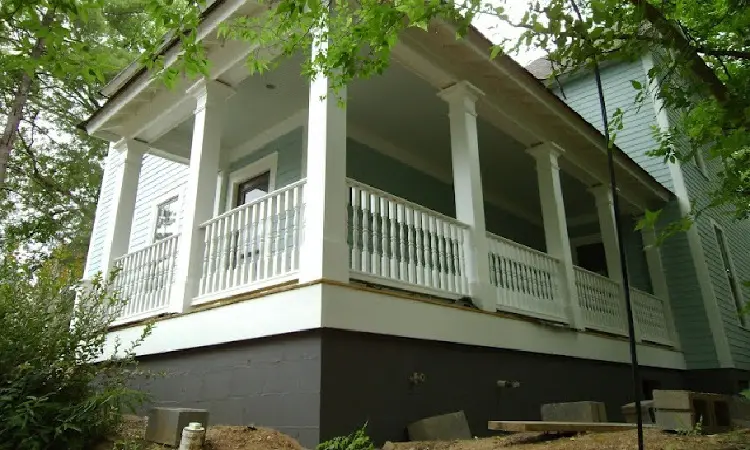
Grey is one of the easiest colors to find for foundation paint, and it is appealing to many tastes.
Neutral colors are often the best choice for foundation paint. Earth tones will draw eyes away from your foundation, and people will look at the house instead.
You may want to paint the foundation the same color as your siding. However, that is not always an option. Many manufacturers do not provide foundation paint that matches the siding paint.
Therefore, professionals often recommend painting your foundation an accent or neutral color.
How to Paint House Foundation
Before you begin painting, you should check how long your paint and primer need to dry. If your paint or primer needs several days to dry, you will need to check the weather.
You will want to avoid heavy wind or rain for a couple of days after applying the paint or primer.
The process of painting brick or concrete foundations is fairly similar, but some differences exist. Below I will describe the steps to paint each type of foundation.
Painting Concrete Foundation
When you paint concrete, you should use a paint sprayer. Paintbrushes and rollers can take significantly more time. They will also absorb more paint than they will apply to the surface of the foundation.
You will want to practice with the sprayer if you’ve never used one before. Cardboard or old drywall can be great to practice on.
To achieve full paint coverage, you should spray the paint sprayer at an even and consistent speed.
Spray the paint straight toward the foundation, not at an angle. It is important to wipe the sprayer’s tip to keep it from clogging.
Many people recommend you paint the corners first and then work from the top to the bottom of the foundation.
Steps to Paint Concrete Foundation:
- Lay down tarps to protect the ground and the rest of the house. You will also want to cover and tape over windows and doors.
- Apply your primer. This is not a necessary step for all foundation paints. You should read the paint can’s label to check if you need a primer. Make sure whatever primer you use is designed for use on foundations. The primer should also have the same base as your paint. You can not use a water-based primer with oil-based paint and vice versa. The spraying technique mentioned above should be used to apply the primer.
- Let the primer dry. The amount of time the primer needs to dry will vary by brand. Read the label on the primer to see how long it will take to dry.
- Paint the foundation. You will use the same spraying technique to apply your paint.
- Let the paint dry per the drying time listed on the label.
- Apply a second coat of paint if needed. Most concrete foundations will need one or two coats of paint for full coverage.
Painting Brick Foundation
Brick foundations can be more difficult to paint because it is a porous material. The surface of the brick will require a primer so that paint can properly adhere to the brick.
The primer will also help seal any small holes and cracks that may not be obvious.
After you complete the prep work that was previously described, you can begin the following.
Steps to paint your brick foundation:
- Lay down tarps to protect the ground and the rest of the house. You will also want to cover and tape over windows and doors.
- Apply the primer. When painting brick, you can use a paint roller or paint sprayer. You will need to apply extra coats on areas affected by efflorescence or mildew.
- Let the primer dry before continuing. Remember that this time will vary for each brand and type of paint.
- Once the primer is dry, you can begin painting. You can use elastodynamic paint or acrylic latex paints. Again, a paint roller or sprayer can be used to apply the paint to the brick.
- If necessary, you can apply a second coat of paint when the first coat is fully dry to the touch.
How to Remove Paint From the House Foundation?
It is possible to remove paint from the foundation of a house. The process will require the use of a pressure washer. Do not worry about damaging the foundation.
Whether your house has a brick or concrete foundation, it can withstand pressure washing.
You will want to focus the pressure washer on the paint you want to be removed. Start with the lowest setting on the pressure washer and slowly increase it if necessary.
You may need a metallic putty knife to scrape away any remaining bits.
Then you can wait 3-4 hours for the foundation to dry. 80-grit sandpaper can be used to remove the remaining stubborn pieces.
If that does not work, you can use a high-quality solvent to remove the paint from the foundation.
3 Best Paints for Concrete Foundation
You know how to paint concrete foundations, but what is the best paint you should use?
Many concrete paints are advertised for painting garage floors, but they can also be used on concrete foundations. Below are the top 3 paints you should look into.
- Rust Bullet Concrete Paint: This paint comes in a wide variety of colors. It is waterproof and resists UV rays.
- Kilz Acrylic Concrete Paint: The paint is only available in one color. It will resist staining from oil and other chemicals. Within 2 hours, the paint will be dry to the touch.
- Rust-Oleum’s Concrete Paint: This water-based paint is resistant to chemicals and UV rays. It is also weatherproof. This line of paint does come in a variety of colors and finishes.
3 Best Paint for Brick Foundation
Once again, you know how to paint brick foundations, but now you need some paint recommendations. I have found the top three paints to use when painting brick foundations.
- Kilz Masonry paint: Nanotechnology is used in this paint to form a barrier that stops water from penetrating the underlying surface. Unfortunately, this paint is only available in white.
- Micro blend Paint: This paint line is available in over 40 colors and 5 different sheen options. It is a high-quality, low-VOC paint. It also offers UV protection.
- INSL-X WaterBlock Paint: This paint offers a mildew-resistant and fungus-resistant protective layer. It can also withstand 12 psi hydrostatic pressure. It is only available in white.
FAQS: Painting House Foundation
Do you still have questions regarding how to paint the foundation of your house?
Below I will answer some of the other frequently asked questions about painting your foundation.
1. Should a House Foundation Be Lighter or Darker?
Generally, the foundation should be darker than the rest of the house.
This helps the foundation blend in with the ground. You want people to look at your house. You do not want their attention drawn to the foundation, right?
Some people prefer to paint the foundation the same color as their siding. There is nothing wrong with this.
This can look amazing and blend the foundation in with the rest of the house when done properly.
2. Much Does It Cost to Paint a Foundation?
Having your foundation painted can cost $1 to $4 per square foot. A 2000-square-foot house can cost anywhere from $200 to $1,100 to paint the entire foundation.
It is significantly cheaper to do it yourself versus hiring a company to complete the job.
3. Can You Paint Your Foundation Black?
It is not recommended to paint your foundation black. It can make the foundation stand out and, therefore, will draw attention away from the house.
Black paint can also absorb heat. That heat can make the house hotter. It can also expose surrounding greenery to more heat.
Verdict
You should paint the foundation of your house. The paint will provide moisture and sunlight protection. It can also increase the curb appeal of your house.
Painting the foundation of your is an extensive process. It is cheaper to perform the project yourself, but it can be very time-consuming.
I hope this article helps you understand why you should paint the foundation of your house. I also hope you now feel prepared to take on the project.


